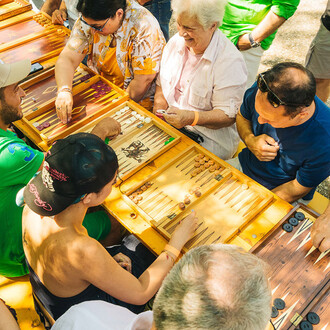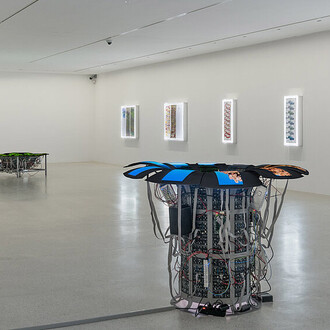Born in 1964 in Stavanger, Norway, Per Dybvig lives and works in Stavanger and Berlin. Dybvig is a traveller of the imagination, exploring white areas on the map and on the white drawing paper where no one has laid their hand before: unconventional arrangement of pictorial space, distortion of perspective and scale, strange details that defy the limits of realism, and almost virtuoso drawing techniques. Dybvig seduces us with precise craftsmanship to enter a world of imagery both beautiful and sinister, like scenes in an absurd play, or like fables where Aesop has lost his train of thought and forgotten the point of the story long ago.
The inspiration for the animations and the drawings that show variations on the hare theme comes from a woodblock print dating back to 1535: The Hunter Caught by the Hares, by Georg Pencz, where the hunter has been hanged from a tree and the hares are preparing for a feast. Dybvig distorts the stylized image of the Renaissance into vivid, rough drawings in the films and into delicate, sophisticated pen drawings in his small gallery pictures. In a bizarre world of images, the finest pen line conjures up peculiar situations and actions. The bizarre, the twisted, and the carnivalesque are established as natural phenomena beyond this world, as André Breton points out in the catalogue for a 1921 Max Ernst exhibition: “Who knows if we are not in this manner being prepared for escaping the principle of identity?”
Dybvig’s draftsmanship is most certainly that of a surrealist; in drawings such as these, he does indeed let his characters escape the principle of identity: here we have a rat-moose on the operating table, a teaspoon-sized man with three hats flanked by a climbing pig, rat-like animals larger than men. These animal fables appear to be without moral perspective. Dybvig leads us towards our outer edges of reasoning, towards the innate laughter of the dizzying imagination, towards the anarchistic edges of the carnival. The human assumes animal form; the animals no longer look like themselves. Is this a rabbit, a fox or a rat? Or is it in fact a rodent moose? This is how Dybvig deflates both the Western myth about the lonesome rider and the traditional idea of hunter and prey.
The drawings move as well, in - up till now - six animated films: the first, Hunter, Hare, Dog, is from 2010. His newest stop-motion animation comes as an accompanying video to Norwegian singer Morten Abel's newest song Evig Din which is also the title of the exhibition. In all of his films, Dybvig lets the sketch pad and the camera become one, as the film's movements are created by a number of still frames which change on paper, slowly and meticulously, from frame to frame. The protagonists and figures take part in an absurd fairy tale where a laconic narrator’s voice part underlines, part contradicts what we see. Norwegian folk tales and classic Western myths meet and shatter each other forcibly.
















